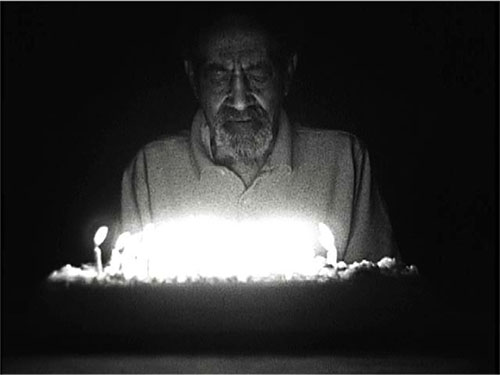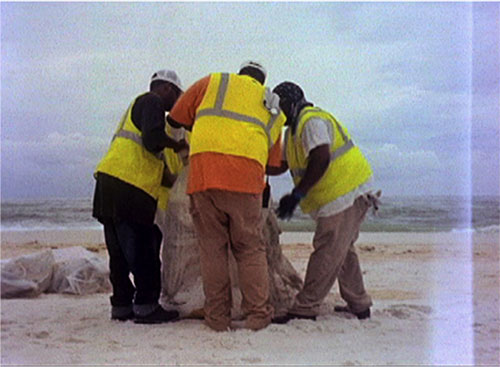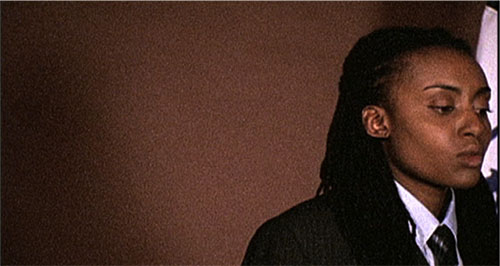Kevin Jerome Everson, a finalist for the 1858 Prize for Contemporary Southern Art, grew up in Mansfield, Ohio. He received an MFA from Ohio University and a BFA from the University of Akron. He currently works as an Associate Professor of Art at the University of Virginia in Charlottesville, where he teaches film.
What is your creative process?
My films combine scripted and documentary elements with touches of formalism. The subject matter is the gestures or tasks caused by certain conditions in the lives of working class African Americans and other people of African descent. The conditions are usually physical, social-economic circumstances or weather. Instead of standard realism I favor a strategy that abstracts everyday actions and statements into theatrical gestures, in which archival footage is re-edited or re-staged, real people perform fictional scenarios based on their own lives and historical observations intermesh with contemporary narratives. The films suggest the relentlessness of everyday life—along with its beauty—but also presents oblique metaphors for art making.

The new work still embraces the similar condition, but I am increasingly interested in interrupting documentary scenes with abstract, formal scenes, those situations where necessity collides with coincidence. The coincidence is the scene that looks as if it was culled from archival footage, an accident or mistake in the actual film material, while necessity is the plot or character that drives the film. I am pleased when these qualities collide in terms of form, because it plays with this ambivalent relationship between art and narrative, fact and fiction. Eventually, I trust that by working in this manner, years from now, I will see my work as achieving pure form.
What is important to my creative process is for the work to reveal the materials, procedure and process. This approach comes from my undergraduate art instruction and influences. My professors, educated at Iowa University and Yale in the 1970s, taught from this standpoint during my college years in the 80’s. It was a post-Smithson approach. I believe that this approach is not necessarily important to be noticeable to the viewer; it merely explains how I continue to approach the craft of art making. I firmly believe that the materials (film, video) of the work must be noticeable. A light flare, over-exposed film, color flares, distorted sounds and even prolonged taping enhance my notion of materiality. Procedure is the formal quality I am exploring with the work. The process is the execution of the formal quality. Once I have a grasp of procedure, the process becomes a discipline. Recently I’ve been making films with single eleven-minute takes, the real-time exposure of a 400’ roll of 16mm film. The materials are the 16mm film and camera. The procedure is that everything has to be framed within a limited time structure. The process is filming everything with that eleven-minute time structure in mind.
Where do you draw inspiration for your work?
I respond to story telling in the Black community. Mostly around the working class Midwest. I am drawn to fragile moments between success and failure in daily life.

Who are your influences?
Comedian Richard Pryor and the playwright Lorraine Hansberry are big influences in my work. Both of these artists herald from the state of Illinois. I respond to Pryor because of his ability to create colorful minor characters and give them depth with one or two lines of dialogue. Hansberry has a knack for creating fragile spaces between success and failure for characters. Also a big influence is the Baroque Italian painter Caravaggio, the American photographer Garry Winogrand, and the Swiss sculptors Peter Fischli and David Weiss.
Do you have a favorite work that you have produced? If so, please describe it.
I made many films that I love but Emergency Needs (2007, 7 minutes, color, 16mm and HD) is one of my favorite films. Emergency Needs is about the first Black mayor of a major metropolitan city dealing with an explosive event in 1968. Carl B. Stokes was elected mayor of Cleveland in 1967. Many credited his election on the devastating east side Hough riots of the summer of 1967. Cleveland was one of a few cities that did not burn down when Dr. Martin Luther King was assassinated in April 1968. However the easy calm did not last long. In the summer of 1968 the east side of Cleveland erupted with the Cleveland-Shoot-Out AKA the Glenville Uprising. The Glenville Uprising was one of the only conflicts where more police officers died than black Americans. Inside the uprising areas, white police officers were indiscriminately shooting innocent black Americans so they could get the number of death balanced (or unbalanced). Mayor Stokes’ solution to the violent acts of the police was to only let black national guard troops, black police officers and black state police officers inside the uprising areas. His planned worked. Emergency Needs uses found footage of Mayor Stokes being cool and calm during several hostile press conferences. The Mayor’s performance was incredible. I wanted to highlight his performances by hiring an actor to mimic the performance. The film uses archival footage of Mayor Stokes buttressed against a re-enactment. It was the first time I had tried re-enacting found footage. Now it is part of one of my artistic practices. Emergency Needs is one of my successful films.

How did you find out about the 1858 Society Prize?
I found out about it through my artist peers.
1858 Prize for Contemporary Southern Art Unveiling Party
Thursday, September 17, 6pm
$25 Society 1858 Members, $35 Non-Members
Location: The Drawing Room at The Vendue, 19 Vendue Range
1858 Prize Dinner
Thursday, September 17, 7:30pm
$100 Society 1858 Members, $135 Non-Members
Location: The Gallery at The Vendue, 26 Vendue Range
For more information or to purchase tickets, please visit gibbesmuseum.org/events
—India Dial, Marketing Intern, 2015
Published August 28, 2015

